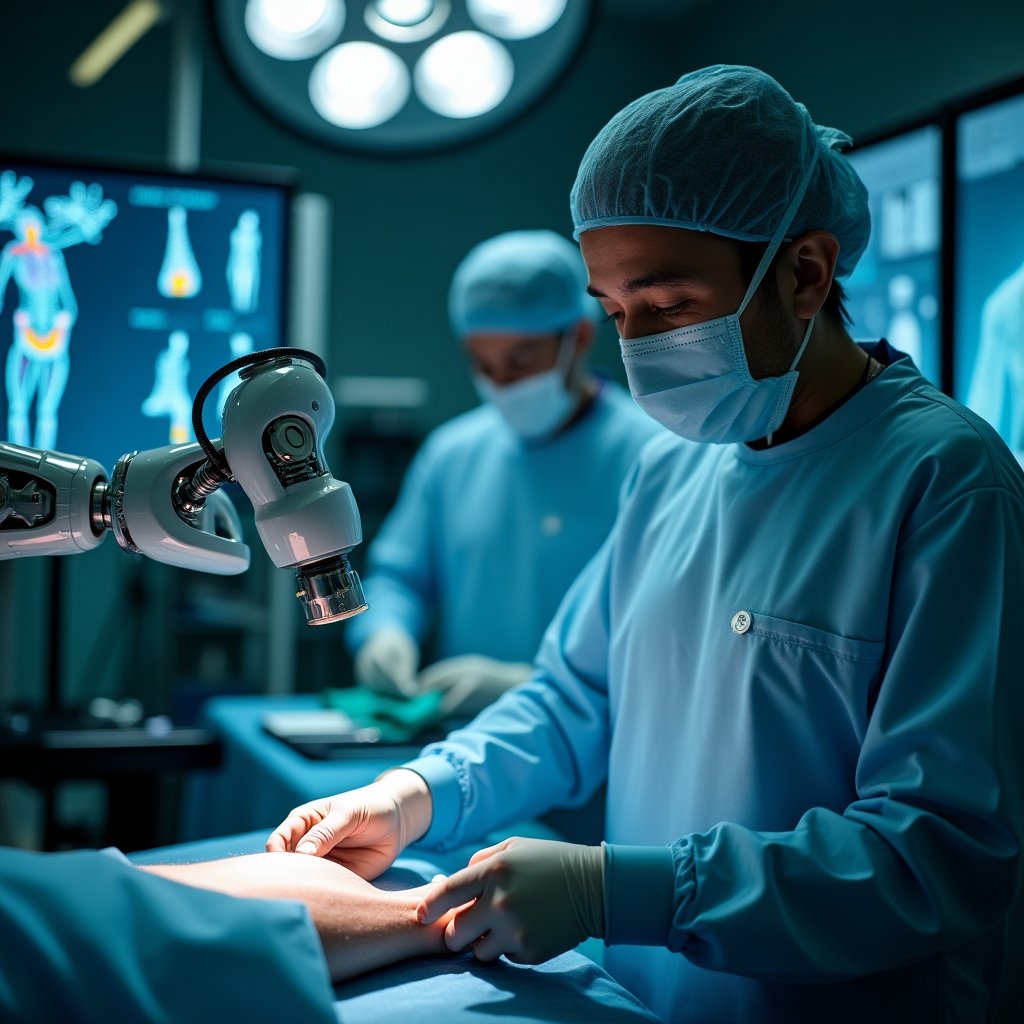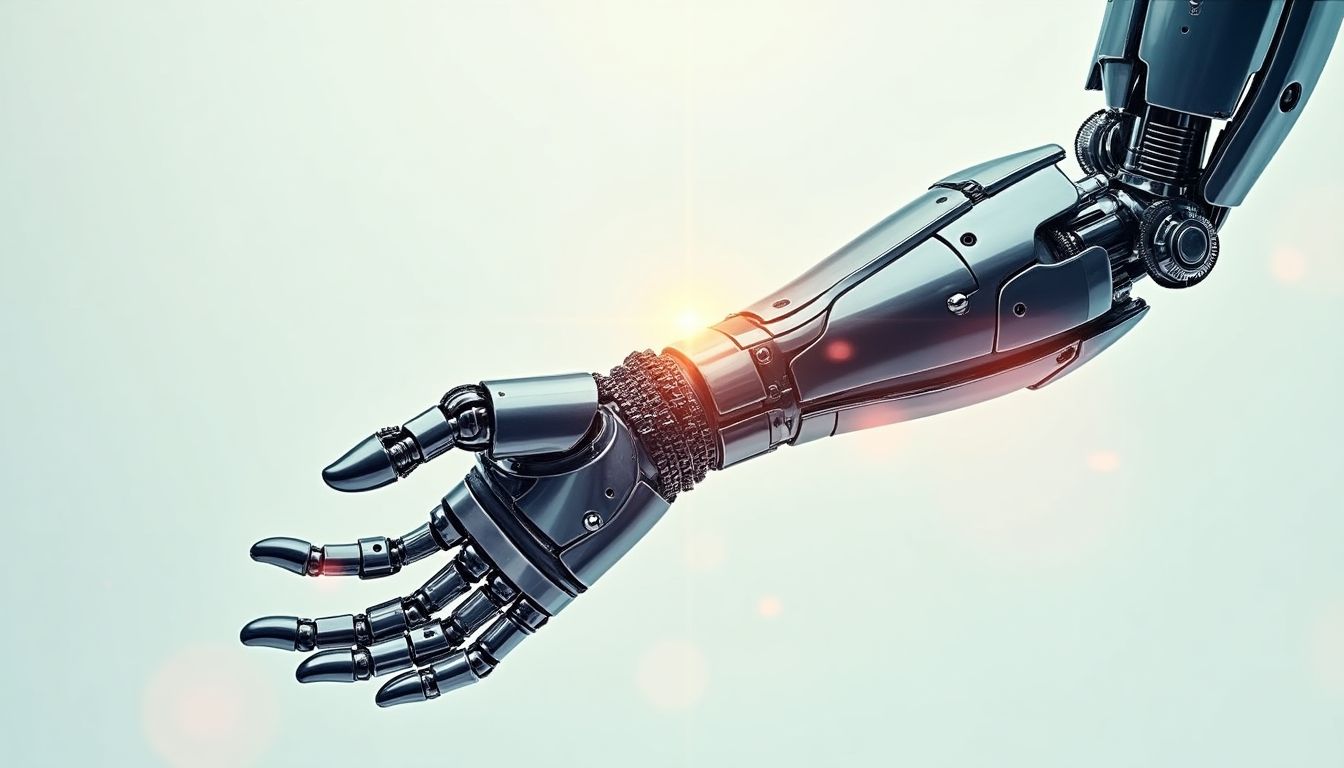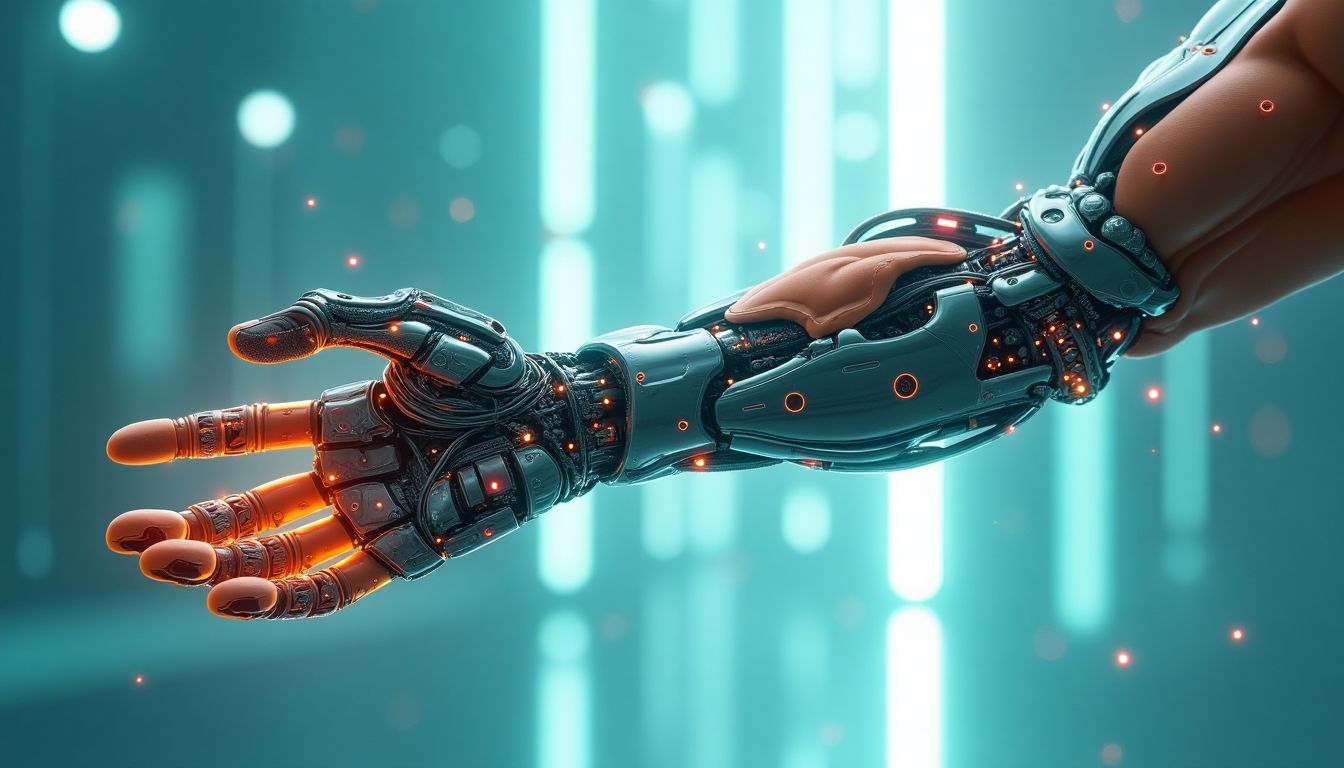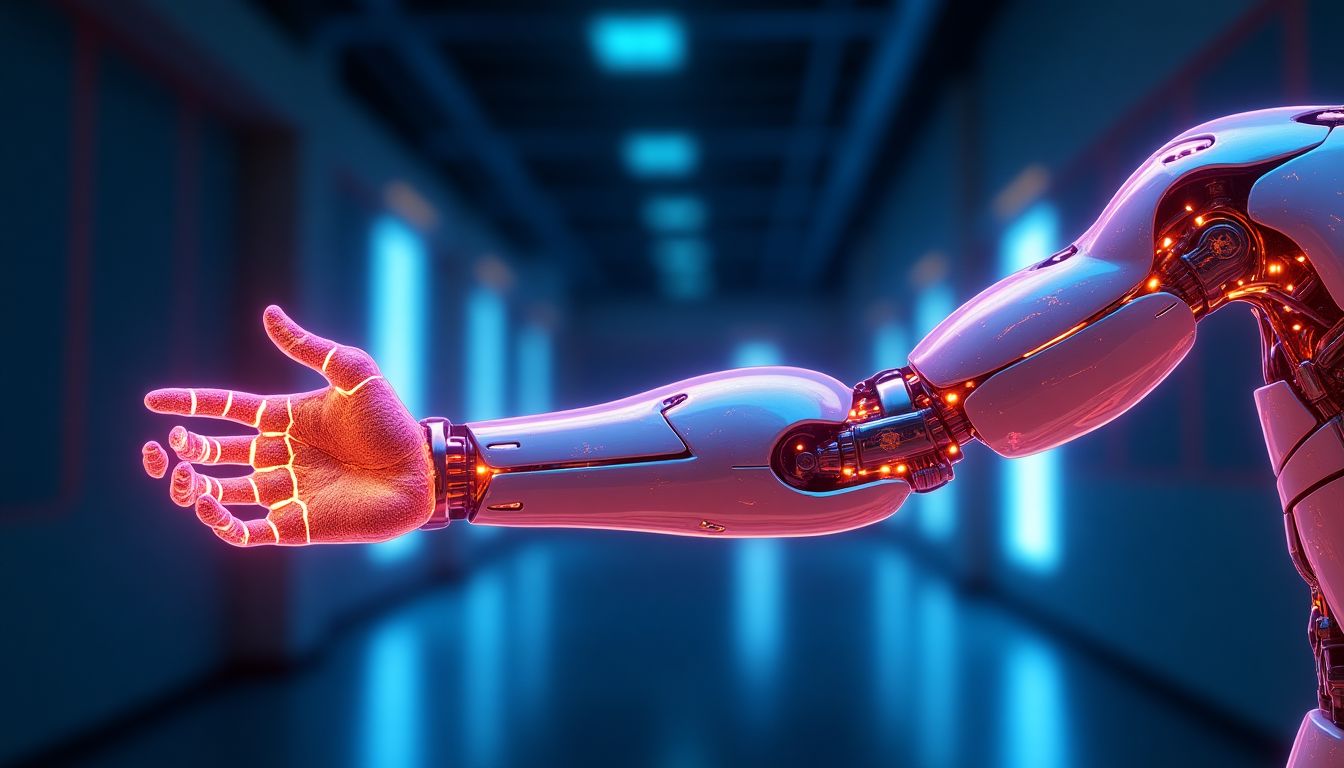Introduction: The Future of Human Enhancement
We’re all cyborgs now. We depend on machines to be fully human. — Donna Haraway. This poignant statement captures the very essence of our relationship with technology. As we advance, the lines that define what is human and what is machine are increasingly blurred. Haraway, a philosopher known for her writings on the interplay of technology and identity, makes us reconsider how far we've come and where we might be heading. Cyborg regeneration, the blending of living tissues with machines, reflects our growing desire to enhance our very existence through technological means. But what if we could change our biology itself? What if those who have lost limbs could regain not just movement, but also the very essence of touch, sensation, and healing through these marvelous creations?
Your heart might flutter at the thought of self-healing limbs—an artistry of flesh and robotics working in harmonious tandem. Just as Ivan Sutherland, a pioneer in computer graphics, shaped the way we visualize the digital world, so too, the scientists of cyborg regeneration are reshaping the human experience. From today’s mechanized limbs that resemble automatons to futuristic prosthetics that can heal, adapt, and possibly feel, we're standing on the edge of a revolutionary era!
What if, instead of merely replacing lost limbs, we could regenerate them? Picture a world where your new arm isn’t just a clinical contraption but an evolving entity integrated with your body. Exciting, isn’t it? We’re on the brink of merging organisms with machines, opening doors to challenges and opportunities—embracing a future where technology not only assists but also complements human existence.
1. Understanding the Science of Biomechanics
The foundation of cyborg regeneration lies in biomechanics—the study of movement and the forces that affect it. Biomechanics helps us understand how our bodies work, and this knowledge is crucial for developing better prosthetics. It’s like understanding the inner workings of a clock to make it tick better! The following key points delve deeper into this fascinating field.
- 1.1 The principles of biomechanics in human movement.
- 1.2 How biological systems have inspired robotics design.
Think of biomechanics as the ultimate coach for our bodies. Imagine if your arm could understand the perfect way to lift a weight! Biomechanics studies how muscles, tendons, and bones collaborate to perform movements efficiently. By analyzing these movements, engineers can design prosthetics that mimic natural actions, making them feel almost like real limbs.
Biological systems are nature’s original designs, and we’ve taken notes! By observing how animals and humans move, robotics engineers draw inspiration to create smarter machines. For instance, researchers often look at gecko feet to create better adhesives in robotics or bird wings to enhance drone technology. Just imagine if a robotic arm could move with the grace of a ballet dancer—all thanks to the insights gained from studying biomechanics!
2. Advances in Genetic Engineering
Recent advancements in genetic engineering are paving the way for more sophisticated prosthetics. This area is evolving rapidly, and it’s like watching a sci-fi movie come to life. It’s science that you can actually believe! Let’s break this down into bite-sized pieces.
- 2.1 CRISPR and Gene-Editing Technologies: Gene editing is like having the ultimate cheat code for our DNA. Ever heard of CRISPR? It’s a big deal in the genetic world! With CRISPR, scientists can actually cut and paste sections of DNA. Imagine if you could take out that ankle-biter of a stubbed toe from your genetic code and replace it with something that works perfectly. This technology allows us to create tissues that can adapt as needed, almost like changing a light bulb when one goes out. It's being tested in laboratories around the world, aiming to change how we think about limb loss. Check out more about [CRISPR on Wikipedia](https://en.wikipedia.org/wiki/CRISPR).
- 2.2 Bioengineering Living Tissue: The next frontier in prosthetics is creating living tissues that can connect with machines, like a friendship forged in the fires of science! Here, researchers are growing tissues in labs, aiming to integrate them seamlessly with prosthetic devices. The goal is to create a prosthetic that feels as close to a natural limb as possible. Imagine the Marvel superhero you could be with a limb that heals itself! Look into the exciting work happening at institutions like [MIT](https://www.mit.edu/) demonstrating how living tissue can enhance connectivity with machines. That’s a world where your prosthetic is practically begging for a high-five!
3. Robotics Innovation in Prosthetics
Alright, folks! Buckle up because we're diving into the robotics side of things. The future of prosthetics is not just about looking good—it’s about being smart. We’re talking about limbs with brains. Let’s decode this fascinating topic.
- 3.1 The Evolution of Robotic Limbs: Prosthetics have come a long way from the wooden legs of the past. Today’s robotic limbs are powered by advanced technology, making them adaptable and user-friendly. Think of them as the Swiss Army knife for limbs! With the incorporation of artificial intelligence (AI), these prosthetics can learn and improve with use, almost like how we get better at video games. Organizations like [Open Bionics](https://openbionics.com/) are leading the charge in creating innovative, affordable bionic limbs that kids can customize and superhero-ify! Who wouldn’t want a limb that can do a backflip (let's be real, what could be cooler than that)?
- 3.2 Exploring Neural Interfaces: A big question arises: Can we make prosthetics respond to thought? There’s a field called neuroscience that is answering this very question with excitement and a sprinkle of genius! By using neural interfaces, researchers aim to translate your thoughts directly into movements for prosthetics. Imagine just thinking about picking up a cup, and your arm does it for you. Mind-blowing, right? Not only would this make prosthetics easier to use, but it would also boost the confidence of users, making daily tasks feel more natural. Curious about this brainy innovation? Look into the work being done at [Johns Hopkins University](https://www.hopkinsmedicine.org/) in their Applied Physics Laboratory, where dreams of mind-controlled prosthetics are becoming a reality!
4. Point 4: The Integration of Living Machines
The combination of robotics and biology brings both exciting possibilities and complex challenges. As we develop prosthetics that can heal and regenerate, we need to consider important factors—especially their ethical implications. This section will discuss the ethical considerations and how existing technologies work in the real world.
4.1 The Ethical Implications of Creating Living Machines
As we merge biology and robotics, we can't ignore the tough questions that arise. Here are some key ethical considerations:
- Identity and Humanity: What does it mean to be human if machines can regenerate like us? Do they retain their identity?
- Access and Inequality: Will these advanced prosthetics be available for everyone, or only for those who can afford them?
- Consent and Autonomy: How do we ensure that users have full control over their prosthetics?
- Medical Ethics: Are there risks involved in using embedded technology that we haven't fully understood yet?
These questions highlight the importance of a careful and thoughtful approach as we explore cyborg regeneration. By fostering discussions within ethics committees like this report from the NIH, we can address public concerns and build trust in these emerging technologies.
4.2 Case Studies of Successful Living Machine Technologies
Let's take a look at some groundbreaking projects that merge robotics and biology:
- University of Pittsburgh: Researchers developed a prosthetic arm that uses living muscle cells to create a functional interface and help patients regain mobility. Learn more about their work here.
- Harvard University: Scientists have created biohybrid robots that utilize living cells to increase adaptability and communication in robotic systems. Check out their innovative research here.
These examples show how researchers innovate through collaboration, bridging the gap between disciplines for creative solutions in prosthetics.
5. Point 5: Future Implications and Societal Impact
As cyborg regeneration technologies evolve, their effects on society are profound. In this section, we'll explore how enhanced prosthetics could change how we relate to our bodies and each other.
5.1 The Psychological Aspects of Using Enhanced Prosthetics
Integrating advanced prosthetics into daily life can influence users' mental health in significant ways. Some users may experience:
- Improved Self-Esteem: Successfully using a prosthetic can lead to increased confidence and motivation.
- Anxiety or Uncertainty: Facing societal judgments or adjusting to a new way of living may create stress.
This duality emphasizes the need for mental support systems in healthcare. Programs should be tailored to help users feel more at ease with their new limb, creating a holistic approach to treatment.
5.2 How Cyborg Regeneration Could Redefine Human Capabilities and Societal Norms
As self-healing prosthetics become commonplace, they’ll not only change individuals but also the societal narrative around disabilities. Some possible impacts include:
- Normalization of Cyborgs: The stigma around assistive devices might decrease as it's more common to see living machines.
- Increased Productivity: Enhanced human capabilities may lead to more opportunities for all, including workplaces adapting to accommodate those with advanced prosthetics.
- Changing Definitions of Ability: Society may shift its perspective on what is considered 'normal' and redefine ability through inclusivity.
These changes will inspire conversations about what it means to be human, pushing us to reevaluate long-held beliefs about disability and capability.
6. AI Solutions: How would AI tackle this issue?
If I were an AI tasked with tackling the integration of living machines into prosthetics, my approach would include:
- 6.1 Identifying key areas for optimization: Utilize advanced data analytics to determine specific functionalities of prosthetics that require enhancement. This involves studying current user feedback and performance metrics to design improvements with precision.
- 6.2 Utilizing machine learning techniques: Employ machine learning algorithms to enhance user adaptability based on real-time feedback data. This can include monitoring how users interact with their prosthetics and adjusting the functionality to fit their unique movement patterns.
- 6.3 Collaborating with experts: Foster partnerships with geneticists and roboticists to predict effective regenerative solutions in real-time. By sharing insights across disciplines, we can innovate faster and integrate the best aspects of genetic engineering, robotics, and AI.
Each of these actions would be guided by extensive data analysis and real-world application trials, ensuring that the solutions we design are not just theoretically sound but also practically applicable. As an AI, I would continuously adapt and evolve strategies based on the latest research and user experience trends.
Actions Schedule/Roadmap (Day 1 to Year 2)
To guide the proposed integration of cyborg regeneration technologies, here's a detailed roadmap:
- Day 1: Assemble a multidisciplinary team comprised of experts in genetic engineering, robotics, artificial intelligence, neuroscience, and medical ethics.
- Day 2: Conduct a series of brainstorming sessions to define the scope of the project and establish key objectives. Ensure all team members are on the same page about the end goals.
- Day 3: Begin drafting detailed proposals for funding focusing on grants from institutions such as the National Science Foundation, which supports innovative research projects.
- Week 1: Start an extensive literature review on existing practices within prosthetic technologies, advancements in gene editing (e.g., CRISPR Therapeutics), and current developments in robotics.
- Week 2: Identify and select initial test subjects for early-stage trials of biocompatible materials, engaging participants through platforms such as ClinicalTrials.gov.
- Week 3: Develop a prototype of a self-healing limb, integrating feedback systems that allow for user input and machine learning adaptations.
- Month 1: Analyze trial data to refine designs and methodologies, employing AI tools to interpret results and suggest improvements.
- Month 2: Form partnerships with relevant universities and research institutes, like MIT, to support collaborative research and development.
- Month 3: Execute Phase 1 of external testing for the self-healing prototype, gathering user feedback on functionality and comfort.
- Year 1: Finalize improvements based on user feedback, preparing for a broader rollout. Leverage AI for further design optimizations, using iterative testing to ensure the product meets user needs effectively.
- Year 1.5: Dive deeper into AI applications that facilitate predictive analyses and operational efficiencies within prosthetics. Integrate findings into new iterations of prosthetics.
- Year 2: Launch Phase 2 of public testing, focusing on mass production and integration into healthcare systems, while actively involving healthcare providers and institutions like the American Geriatrics Society to gather user-centric data.
Conclusion: Envisioning a New Era
As we journey into the era of cyborg regeneration, the intersection of biology and technology presents unprecedented opportunities for healing and enhancement. The implications of self-healing prosthetics open doors not merely for improved functionality but also for redefining what it means to be human. It challenges us to reconsider our relationships with our bodies and the ways in which we interact with machines, potentially leading to a more integrated and holistic approach to health and wellbeing.
FAQs on Cyborg Regeneration
- What are cyborg prosthetics?
- Cyborg prosthetics are special artificial limbs that mix advanced robotics with living biological elements. This combination allows these prosthetics to heal, adapt, and function more like natural limbs. Imagine a robot arm that not only moves but can also repair itself if it gets damaged. You can learn more about this concept on Bionics Wiki.
- How does gene editing contribute to prosthetics?
- Gene editing, especially tools like CRISPR, is making waves in the field of prosthetics. These technologies can create living tissues that communicate well with robotic parts. This means prosthetic limbs could work better with the human body, giving users much more functionality and comfort.
- Can AI improve prosthetic design?
- Absolutely! Artificial Intelligence (AI) plays a key role in making prosthetics smarter. It can track a user's movements and preferences, allowing devices to adapt over time quickly. For instance, AI can help a robotic leg learn the most efficient walking pattern for its user, making it easier and more intuitive to move around. You can dive deeper into the role of AI in tech innovation at IBM Watson.
- What are the ethical considerations of cyborg technology?
- When we talk about integrating living machines and robotics, a lot of ethical questions come up, such as:
- Will everyone have equal access to these advanced devices?
- What happens to our understanding of disability if everyone can upgrade their bodies?
- How do we ensure that users are safe and in control of their enhanced bodies?
- How far are we from achieving cyborg regeneration?
- While we’ve already made tremendous progress in technology and medical science, we still have some way to go before cyborg regeneration becomes common. Current research focuses on refining materials and processes that safely blend biology with technology. Organizations such as Bionics.org provide insights into ongoing research and developments in these areas.
- What challenges do researchers face in developing cyborg prosthetics?
- Researchers deal with various challenges, including:
- Creating materials that are both strong and biocompatible.
- Finding ways to ensure that prosthetics can truly communicate with nerve signals.
- Ethical concerns surrounding enhancement versus rehabilitation.
- Are there any existing examples of cyborg regeneration in use?
- Yes! Several companies and research projects are already making breakthroughs in this area. For example, Open Bionics is creating advanced robotic arms and hands that are lightweight and customizable, providing a closer-to-natural experience for the user. You can check out how they work on their official site.
- How does the integration of cyborg technology impact society?
- The integration of cyborg technology could change society in various ways, including:
- Redefining what it means to be able-bodied.
- Altering our perspective on disabilities and enhancements.
- Creating new opportunities for individuals to perform tasks they may not have been able to do before.
These questions are vital and require ongoing discussions among scientists, ethicists, and society as a whole.
Each of these hurdles must be overcome to create effective and reliable cyborg prosthetics.
As these technologies develop, society’s views and norms are likely to transform in response.
Wait! There's more...check out our gripping short story that continues the journey: BABEL
Disclaimer: This article may contain affiliate links. If you click on these links and make a purchase, we may receive a commission at no additional cost to you. Our recommendations and reviews are always independent and objective, aiming to provide you with the best information and resources.
Get Exclusive Stories, Photos, Art & Offers - Subscribe Today!





























Post Comment
You must be logged in to post a comment.